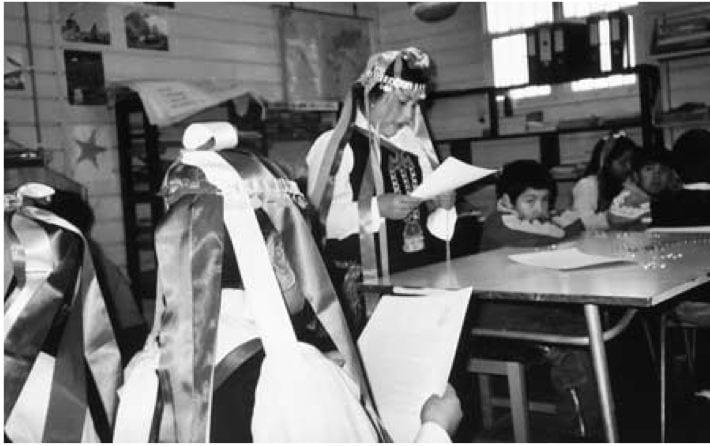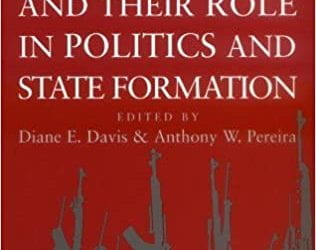Children and Globalization
Schools, Children and Trust in the Americas

Jerónimo reads to the class as they celebrate their Mapuche heritage. Photo by Fernando Reimers
I’ve spent an hour talking to the children in this school in the south of Chile. I’ve carefully looked at their well-kept notebooks. I’ve heard them read from their books and asked them questions about what they have read. Later I will discuss with the teacher what he tries to do when he teaches them reading. And then the children will be asked to demonstrate some of what they have learned in math and in science and to read some poetry in Mapudungun—the language of the Mapuche, the indigenous group that claims the identity of most of the children in this school.
But I will focus on these things later, for now I’m listening to the children. I’m looking at them. Eight-or-so boys and girls surround me as I study their notebooks. The rest work at small desks or talk with their teacher. Jerónimo, a 10-year old with bright eyes, is more engaged than the rest. He is curious about the purpose of my visit. Finally he asks me “De donde vienes?“—Where do you come from? I tell him that I come from the United States. He pauses to think and then says, “De donde los aviones se estrellaron contra las dos torres?“—Do you come from the place where the airplanes blew the two towers up? I tell him that I do come from the place where hijackers crashed several airplanes against very tall buildings almost two years ago. The other children listen attentively as I answer Jerónimo’s question. I ask him where he has learned about this; “I heard it on TV,” he replies. I ask him whether he has talked about this in school and he replies that he hasn’t. He swiftly goes back to his notebook and school work. Jerónimo is enjoying showing me how good a reader he is. He is a good reader and a good thinker. He asks good questions.
During the rest of my trip to Chile last summer to study the impact of government policies in supporting instructional improvements, Jerónimo’s questions and my questions about his questions stay in my mind. Why was the image of the collapsing World Trade Center the first idea Jerónimo associated with the United States? Why did his questions find no room in the curriculum of instruction? What do other children in Chile learn about the U.S.? What do they learn about their neighbors in Bolivia? What do children in Bolivia learn about their neighbors in Chile? What do children in the U.S. learn about Mexico, Canada, Brazil or Chile? What do children in these countries learn about the U.S.? What do all of the children in the Americas learn about each other? About the interdependent nature of the challenges they face? About the opportunities for collaboration across national borders?
Against the backdrop of those questions inspired by my visit to schools in Chile, I subsequently follow the news of the opposition to Free Trade at the WTO meeting in Cancún and the development of events in Bolivia in opposition to the gas pipeline that would run through Chile. I ponder the subsequent address of Evo Morales, the leader of the cocaleros in Bolivia, to the assembly of the Latin American Council of Social Sciences in which he declared that Latin America will be another Vietnam for the United States. I reflect on the latest findings of the Latinobarómetro poll that documents increasingly negative attitudes towards the United States in several Latin American countries. I reflect on the failure of the presidential summit in Monterrey last January to result in any substantive agreement to improve the well-being of people in the Americas.
I find these questions and events unsettling because I believe the prospects for expanding human potential throughout the Americas rest in the skills and willingness of people and their leaders to deepen economic and cultural exchanges. Global coalitions and resources must address the persistent and interdependent challenges of poverty and inequality, political instability, violence, environmental degradation, poor health and malnutrition, joblessness, weak and fragile scientific and technological communities, elusive human rights, small markets, marginalized cultural and artistic communities and multiple constraints on freedom to speak, think and act.
The continued development of freedom and capabilities in this hemisphere to address these persistent challenges depends on collaboration to consolidate open societies and in the unrestrained flow of ideas, people, capital and resources across national borders. Historical examples do exist to illustrate the benefits of global flows of ideas—such as the independence movement in the Americas or the 19th-century intellectual exchanges between Horace Mann and Domingo Faustino Sarmiento that led to the creation of public education systems in North and South America. However, telecommunication technologies and global institutions now decidedly enhance the potential for inter-hemispheric collaboration. Globalization—the availability of a physical and institutional infrastructure that makes it possible to mobilize resources to create value, solve problems and seize opportunities on a transnational scale—affords an unprecedented prospect to reframe and address these persistent challenges. Paradoxically many still see globalization, or a narrow manifestation of this process, as contributing to these problems, rather than to their solution.
Many obstacles to seizing the opportunities that globalization makes possible are in the minds of people, in their fears and prejudices and in their lack of knowledge about each other. Schools throughout the Americas are failing to address the most serious challenges and opportunities involving economic, social and political interdependence in the hemisphere. Unlike schools in European Union, the classrooms in the hemisphere, from Jerónimo’s school in the Chilean south that left him with unanswered questions to those in the most northern reaches of Canada, are not preparing children to understand how the local conditions that will influence their lives are shaped by global forces and events. Global Education, an established body of work and practice in the field of education, is absent from the curriculum of most schools in the American hemisphere. This state of affairs is so deeply embedded that few question whether the purposes of schools are appropriate to prepare children for fulfilling lives in a global and ever more integrated world. When raised, these questions are typically faced with paranoia, with fears that they represent imperialistic designs or attempts to undermine national sovereignty and unity.
Schools, teachers and textbooks sometimes teach fear and mistrust of hemispheric neighbors overtly, as government-sanctioned textbooks for mandatory high school use in Venezuela did only three years ago:
Beginning in the seventies, as a result of our oil boom, of populist policies and of State paternalism, and as a result also of negative economic and social situations in many Latin American countries, the country saw an indiscriminate and uncontrolled avalanche of immigrants from Colombia, Ecuador, Peru, Dominican Republic, Trinidad, Cuba, and other countries in Central and South America who, in a great majority without formal education, without skills, with traumas, diseases, came in search of the easy bolívar (the national currency) that Venezuela offered. In addition to their impact in our national identity we should ask: what will the attitude and position of many of these foreigners be in the event of international tensions or conflicts? Specifically, in the event of conflict with Colombia: what will be the attitude of a Colombian when as mandated in their Constitution they do not loose their nationality even if they become naturalized Venezuelan? Will their national identity be with Colombia or with Venezuela? How many of them will become involved in espionage or sabotage to the basic industries, to the oil industry?” (Vásquez, M. 1999. Instrucción Premilitar. Editorial Biosfera. Caracas. Venezuela. Aprobado por el Ministerio de Educación segun Resolución No 148 del 7 de Julio de 1999. pages 58-59. My translation.)
The same textbook goes on to identify cultural exchanges among nations as the source of the destruction of national identity. The book explains that the press, the radio and television have been the main agents of this accelerated transculturation: “None will be able to deny the socially negative effects caused by North American television through the Venezuelan television” (Ibid, page 59).
Children in other countries in the Americas may be taught such an explicitly negative portrayal of globalization, of the flows of ideas and people. However, schools everywhere in the hemisphere are doing too little to develop the skills and dispositions that will help citizens take advantage of the opportunities for collaboration now within reach. As a result, at a time when globalization has created unprecedented opportunities for transnational partnerships in addressing critical problems, many in the Americas perceive globalization itself, as well as the international institutions that make it possible, with fear and mistrust. Never has the narrow focus of instruction in the United States and the lack of emphasis in teaching geography, foreign languages and area studies been more counterproductive. Ten years after Canada, Mexico and the United States signed the North American Free Trade Agreement, schools in these countries still breed ignorance and prejudice about the partners in this strategic economic alliance. Perhaps this renewed parochialism reflects broader and deeper currents favoring isolationism from the world community. New regulations of the Immigration and Naturalization Service have reduced the inflow of foreign students to universities in the U.S. thus limiting the opportunities for many college and graduate American students to learn from a diverse group of peers. Consistent with this narrowing of the curriculum in American educational institutions, funding for American cultural and public diplomacy is dwindling, representing less than one percent of the defense budget.
This inability to prepare children in the Americas for greater mutual understanding, appreciation and cooperation is the greatest failure of education reform in the hemisphere. Most schooling still reflects the values that served local elites to consolidate nation states and to create national identities. The ill disposition toward neighbors—when not outright bigotry, prejudice or ignorance—served in the past to promote the local petty politician or small business leader seeking to carve out a protectorate. However, these learned values work at cross-purposes with the knowledge, skills and habits of mind that support open societies, internationalism, commitment to international covenants and institutions, free trade and a greater understanding of the many opportunities for collaboration and partnership throughout this hemisphere.
School curricula must be developed to enhance inter-hemispheric understanding through materials that are nonbiased, accurate and reflective of diverse views. This reform must extend beyond the largest countries that are most obviously interdependent because of the large scale of their trade or those that hold the largest energy reserves in the hemisphere, for no nation can prosper in a troubled neighborhood. Progress in expanding human freedoms will be continuously challenged by pockets of instability caused by failed states, and by the ensuing intense polarization and pockets of authoritarian rule of the left or of the right.
This failure of schools to prepare the citizens of the Americas for more intense collaboration and interdependence is understandable. Most nations in the Americas are still struggling to provide universal compulsory education of decent quality to all children. Tactical issues of means often fill up the agenda of school leaders and prevent them from engaging with strategic issues of purpose. Most schools in the Americas are still struggling to resolve 19th-century challenges such as teaching children to be competent readers. In so doing they have failed to seize the opportunities of the later part of the 20th-century and are thus not preparing children for the 21st-century.
In particular, schools are not actively contributing to building global trust. This is more than an abstract ideal. It involves a set of skills and habits of mind and knowledge of subject matter—of history and geography, linguistic competencies and metacognitive skills—that allow people across national divides to see those born in other nations as equals and as potential partners and to collaborate with them with respect and positive dispositions to create opportunities for mutual gain. Schools that fail to teach students to read at high levels have not yet begun to develop the multiple linguistic competencies that will make greater communication and collaboration possible in the hemisphere. Schools that provide very limited opportunities to develop inter-personal trust, to learn about reciprocity and to build social capital, fail completely at developing hemispheric trust.
Most education reforms have missed the mark. Simple-minded solutions to improve the efficiency of educational institutions have prevented reflection on the purposes of schools. They have failed to take into account the changing context that globalization has created during the last decade. Important challenges and opportunities of our times call for concerted efforts across national boundaries. Complex intellectual creation in many disciplines, advancement of science and the arts, promotion of health and solution of epidemics, preservation of the environment, control of international criminal activity, resolution of international disputes and, by definition, greater economic integration and trade cannot take place within the confines of one country. Yet schools in the Americas continue in their 19th-century task of domesticating minds into the socially constructed divides that shaped the boundaries of the past.
The responsibility for this poor state of affairs is widely shared. It rests most obviously in the hands of policy elites and government bureaucrats who in the quest to provide mass education at low cost often mistake means with ends. They focus on secondary challenges such as school attendance and grade retention rates. Primary questions such as the purposes of schools often remain unexamined. Even worse yet, those entrusted by taxpayers and voters to administer what is in most places the largest industry often use public means to advance private ends, to build political machines, to reward loyalties and to improve the livelihood of friends and relatives. But politicians and bureaucrats have been in good company in failing to prepare teachers to develop global inter-hemispheric literacy and trust. Business elites, fascinated by math and science as the engines of modern economic prowess, have focused their energies in lobbying for greater curriculum attention to these subjects and for efficient productivity in learning. In spite of, or perhaps because of, these efforts, children in Latin America today score at world lows in math, science and literacy in the countries that have participated in international comparisons of student achievement. This suggests that measuring results alone does not lead to improvement. More importantly, measuring student performance on a limited range of low order cognitive skills has proven to be of little consequence to help citizens create and seize the opportunities made possible by globalization. International development institutions have joined business and policy elites in this uncritical enthusiasm for strategies to provide mass schooling at low cost. Poorly educated citizens in turn continue to elect leaders who are not significantly more skilled in bringing about peace, stability and hemispheric progress.
The task of fostering global understanding in the Americas is one that calls for greater coordination and collaboration among countries in the region in defining the purposes of schools. The failures of the education systems in the Americas to collaborate and define what teachers should teach are most evident when contrasted to a number of collaborations in the European Union and to emerging efforts to teach about other parts of the world in schools in the United States.
In 1976, education ministers in the European Common Market agreed to set up a research and information collaborative of centers to facilitate the exchange of educational experiences and to support policy development in the Common Market’s nine countries. This agreement resulted in the creation of EURYDICE, a research and information network on education in Europe. EURYDICE has facilitated the exchange of ideas based on comparative research. Since the establishment of this network for the exchange of ideas and best practices, all countries of the European Union have undergone ambitious reforms of both K-12 and higher education. EURYDICE has supported these reforms facilitating the exchange of ideas and institution-building, and has studied the design and implementation of these reforms as a way to further support the consolidation of these changes. In 1986 the early focus on the exchange of research findings was supplemented with strong programs of student exchanges, through the very large and comprehensive Erasmus program.
Once an integrated European market developed in 1992, education formally became a legitimate area of Union focus, recognized in the Maastricht Treaty. Articles 149 and 150 of the Treaty define the Community’s role as contributing to improving the quality of education in the Union encouraging cooperation among member states and supporting and supplementing their action europa.eu.int/comm./education/policy_en.html. Current educational collaborations in the European Union have extended to programs that support education of children and youth at all levels (the Socrates program and Leonardo da Vinci program) and the introduction of European studies at the college level (the Jean Monnet project) while increasing the development of common standards for higher and professional education.
Over time EURYDICE has consolidated itself as an observatory of education reform in the Union. Current and recent comparative analyses have focused on such subjects as cooperation in education, early childhood education, financing of education, foreign languages, educational planning, information technology in education, key competencies, lifelong learning, management and evaluation of schools, organization of education, private education, reforms of education, school failure and dropouts. (See www.eurydice. org/doc_intermediaires/analysis/en/analysis.html.)
Education collaboration in the European Union has gradually addressed more ambitious goals. Last year, the European Council identified education as one of the bases of the European social model and established the objective of reforming education systems to achieve the highest world standards by the year 2010.
The underachievement of inter-American collaboration in defining instructional purposes is also apparent in comparison to modest emerging international foci of U.S. education curriculum policy. Recent initiatives in the United States are beginning to address the deficits in the curriculum in preparing students for international understanding. However, they do not give priority to learning about countries and cultures of the Americas. Exemplary models include the efforts of the Asia Society to boost an emphasis on Asia in school curricula. A recent report circulated among education and business elites in the US identified “a huge gap between the strategic importance of Asians’ and Americans’ disproportionate lack of knowledge about this vital region. [The] report analyzes the strengths and weaknesses of current teaching and learning about Asia and Asian American topics in U.S. primary and secondary schools. It sets forth actions needed to improve the quality and broad accessibility of such instruction” (Asia Society. Asia in the Schools. Preparing Young Americans for Today’s Interconnected World. 2001). Similar recent initiatives include also a new program of the U.S. Department of Education to support the development of instructional materials on the Middle East, Central Asia and South Asia and the languages spoken in these regions Analyses can be found at www.ed.gov/legislation/fedregister/announcements/2003-3/082603c.html. Efforts such as the Massachusetts Initiative for International Studies are attempting to spearhead the conversation about the need for more attention to these topics in the curriculum among educational leaders in the Commonwealth.
In the south of Chile a 10 year-old named Jerónimo has questions about his neighbors in the hemisphere who live in the United States. His teachers do little to help him answer these questions. Jerónimo is not alone in the opportunities that he is missing to develop global literacy and global trust, a new set of fundamental skills and dispositions to seize the opportunities of the 21st-century. His peers in the United States, in Canada, in Mexico, Brazil, Venezuela, and elsewhere in the hemisphere are equally constrained in their opportunities to learn to appreciate and understand the interdependent nature of the challenges they face and to develop the skills to address those collaboratively.
It is high time to move away from applying 19th-century solutions to 20th-century educational problems and to start using all the educational resources of our times to develop the skills and dispositions that build global trust in the Americas.
Winter 2004, Volume III, Number 2
Fernando Reimers is Associate Professor of Education and Director of the International Education Policy Program at the Harvard Graduate School of Education. His research focuses on policies to improve the quality and relevancy of education in open societies.
Related Articles
Editor’s Letter: The Children
A blue whale spurts water joyfully into an Andean sky on my office door. A rainbow glitters among a feast of animals and palm trees. Geometrical lightning tosses tiny houses into the air with the force of a tropical hurricane.
Centroamerica
Cuando Pedro Pirir, fue despedido del taller mecánico donde trabajaba desde hacía muchos años, experimentó una sensación de injusticia y pena que luego se transformó en una voluntad…
Irregular Armed Forces and their Role in Politics and State Formation
As I sat in heavy traffic in the back of a police car during rush hour in the grimy northern zone of Rio de Janeiro, I studied the faces of drivers in neighboring cars, wondering what they thought of…




